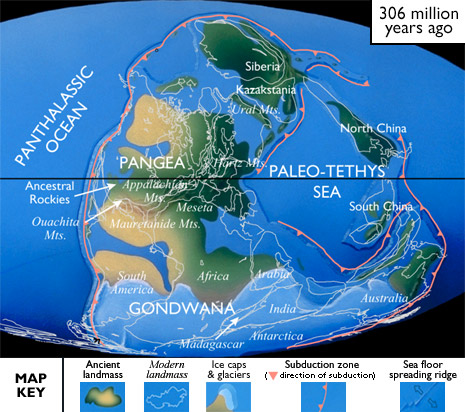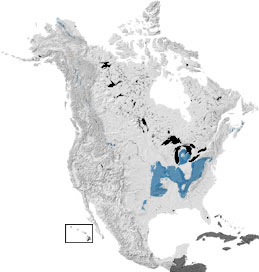the Carboniferous - 354 to 290 Million Years Ago
|
See the Carboniferous in: Or jump to another period: |
Links to more about the Carboniferous
Careers | Research and Collections | Organizations | Education and Exhibits | Research and Collections | Resources
CareersResearch and Collections(showing 1 of 1 listings)
Organizations(showing 1 of 1 listings)
The Natural History Museum, London's conodont collection: This database gives broad information about discrete collections within the conodont collection housed at the NHM. Generic, specific and subspecific names are included in the database, but the data is being updated regularly. As a result, the database is best searched by name of donor/collector/publisher or by geological period. Links to images are included with some collections.
Education and ExhibitsSocieties and Clubs (showing 1 of 1 listings)
KYANA Geological Society - Louisville, Kentucky: We are a non-profit educational organization, which was founded in 1961, to promote the interests of geology, minerals, fossils, and lapidary arts in Kentucky and Southern Indiana.
Museums (showing 3 of 4 listings)
Joggins Fossil Centre: The Centre features a museum which highlights the fossil record of the Carboniferous Period. Specimens from Joggins are on display illustrating the great diversity of life preserved in the Joggins Fossil Cliffs. Guided tours of the site are also available.
Alabama Museum of Natural History: Collections: Experience the natural diversity of Alabama through exhibits from the Age of Dinosaurs, the Coal Age, and the Ice Age. View the Alabama Museum of Natural History's extensive collections of geology, zoology, mineralogy, paleontology, ethnology, history, and photography. Located in historic Smith Hall on the University of Alabama campus, the Museum's mission is to broaden the knowledge of natural sciences and human culture through collections and quality programs of research, instruction, and service; many family-friendly events are offered.
Burpee Museum of Natural History: The mission of Burpee Museum of Natural History is to inspire all people to engage in a lifetime of learning about the natural world.
Research and CollectionsVirtual Exhibits (showing 3 of 10 listings)
Mazon Creek Virtual Exhibit- University of California Museum of Paleontology: This page has more detailed information and additional links on the fossils at Mazon Creek, as well as the rocks, environment, plants, and animals of the Carboniferous.
Mazon Creek Fossils: Hosted by the Illinois State Museum in Springfield, IL, this site is a great resource for information on the rocks, fossils, and history of the Mazon Creek area, including many excellent images.
Ancient Denvers: Ancient Denvers is a virtual exhibit that highlights 13 reconstructions of ancient Colorado landscapes.
ResourcesResearchers (showing 3 of 5 listings)
University of Iowa Paleontology Repository: The UI Paleontology Repository is home to over a million fossils from all over the world and from all time periods, and is used for research and teaching. We also provide education services, hands-on tours around the collections and geology exhibits for schools and community groups, and fossil identification and collection care services.
University of Kansas Paleobotanical Collection: Collection of fossil plants currently housed at the University of Kansas.
Dr. Thomas W. Kammer: Specialty: Evolutionary paleoecology of Paleozoic crinoids, plus lithostratigraphy, biostratigraphy, and sequence stratigraphy of marine Mississippian rocks in the east-central United States. Field areas include West Virginia, Kentucky, Indiana, Illinois, Missouri, and Iowa.
Ongoing Research Projects (showing 3 of 7 listings)
Sam Noble Oklahoma Museum of Natural History: On the campus of the University of Oklahoma in Norman. One of the finest university-based museums in the nation, with an active Paleontology research program and extensive collections.
Vertebrate Paleontology Laboratory, UT: The University of Texas Vertebrate Paleontology Laboratory houses one of the 10 largest collections in North America, and it supports one of the Nation's largest graduate education programs in paleontology. It also supports public exhibits at the Texas Memorial Museum.
Paleontology and Geology of Missouri: This site is a Paleontological research project based in
St. Louis, Missouri, devoted to the study of the geological
formations in Missouri. Primary focus is the study of the
fossils found in these formations.
Maps (showing 1 of 1 listings)
Paleogeography and Geologic Evolution of North America: The images presented here show the paleogeography of North America over the last 550 million years of geologic history.
Courses and Lectures (showing 1 of 1 listings)
Paleogeography of the Southwestern U.S.: The paleogeography of the southwestern U.S. from 1.8 billion years ago to 10 million years ago. Text and images by Dr. Ron Blakey from Northern Arizona University.
Image Collections (showing 3 of 3 listings)
Michigan Basin Specimen Database: This site showcases Michigan Basin fossils from the private collections of Friends of the University of Michigan Museum of Paleontology and select specimens from the University of Michigan collection, including type specimens.
Some Fossil Brachiopods: Images of several fossil brachiopods, dating in geologic age from early Cambrian to Pleistocene, with explanatory text.
Pennsylvanian Footprints in the Black Warrior Basin of Alabama: This documents rare animal trackways and other trace fossils from the Carboniferous, collected from a surface coal mine in Walker County, Alabama.
Field Guides (showing 2 of 2 listings)
Fossil Cephalopods in Utah: A reference to help provide information on the identity, biostratigraphy and location of fossil cephalopods found in the state of Utah.
High Inyo Mountains Fossils, Inyo Country, California: Visit a classic 325-million-year-old fossil locality near the crest of California's Inyo Mountains; detailed text; images of fossils; scenic images.
Databases (showing 3 of 4 listings)
New Mexico Museum of Natural History and Science Web-based Paleo-database Home Page: Search the fossil collections of the New Mexico Museum of Natural History and Science. Listings by Kingdom down to species, era, epoch, group, formation, country, New Mexico county, and map ID. Many listings contain images of the fossils (including all holotypes.)
The Paleointegration Project: The PaleoIntegration Project (PIP) is facilitating interoperability between global-scale fossil and sedimentary rock databases (e.g. The Paleobiology Database and the Paleogeographic Atlas Project), enabling a greater understanding of the life, geography and climate of our planet throughout the Phanerozoic. Databases can be searched via text and interactive maps, and by any combination of age, location, or content. Results can be plotted on present- and paleo- maps or downloaded for detailed analyses.
Fossils in My Back Yard: Explore a geologic map of Iowa, county by county, to see lists and photos of fossils in the collections of the University of Iowa Paleontology Repository.
Annotated Bibliographies (showing 1 of 1 listings)
Bibliography of Paleobotany: A bibliographic database of paleobotany including more than 56,000 entries. It also includes references on Antarctic geology and paleontology and citations on Women in Science.
General Reference (showing 2 of 2 listings)
Fossils In Death Valley National Park: The paleontology, geology and natural wonders of Death Valley National Park (and more); many images of fossils; field trips; paleontology links, plus links to Death Valley.
List of Dinosaurs: This dinosaur listing is data-packed and can be sorted by dinosaur length, weight, time period, etc.

